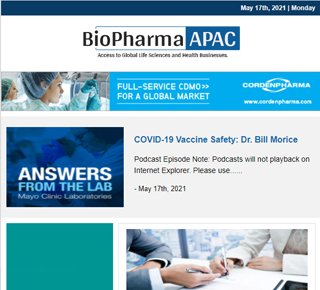AstraZeneca’s AIRSUPRA Cuts Severe Asthma Exacerbations by 47%, Redefines Mild Asthma Treatment Standard
20 May 2025 | Tuesday | News

AIRSUPRA demonstrated a 47% reduction in the risk of severe exacerbations in mild asthma compared with albuterol alone
Full results published in the New England Journal of Medicine and presented at ATS 2025 International Conference
Positive full results from the BATURA Phase IIIb trial showed AstraZeneca’s anti-inflammatory reliever rescue therapy, AIRSUPRA (albuterol/budesonide), demonstrated statistically significant and clinically meaningful improvements in all primary and secondary endpoints compared to albuterol in patients with mild asthma.1,2 These data were published in the New England Journal of Medicine and presented today at the American Thoracic Society (ATS) 2025 International Conference in San Francisco, CA.1
The trial measured as-needed AIRSUPRA compared to as-needed albuterol, the most commonly used rescue medicine in the US.3 The BATURA trial demonstrated treatment with AIRSUPRA significantly reduced the risk of a severe exacerbation by 47% (5.1% , 9.1%, hazard ratio [HR] 0.53; 95% confidence interval [CI], 0.39, 0.73; p<0.001) when compared with albuterol alone. The overwhelming efficacy of AIRSUPRA at a pre-specified interim analysis led to the early stop of the BATURA trial as recommended by the Independent Data Monitoring Committee.4
BATURA builds upon the previous Phase III MANDALA and DENALI trials and in totality, the clinical program demonstrates the benefit of as-needed AIRSUPRA in reducing the risk of severe exacerbations across all asthma severities compared to albuterol alone.3,5 This BATURA data also aligns to the latest global recommendations from the Global Initiative for Asthma which recommends an anti-inflammatory reliever combination therapy taken as-needed as the preferred reliever therapy in mild asthma.6
Mild asthma, affecting 50% to 70% of patients, is often assumed to be low-risk, yet can result in severe or even fatal exacerbations.7,8 People with mild asthma or infrequent asthma symptoms represent up to 30% of all reported asthma-related exacerbations and deaths.7,8
Craig LaForce, MD, Medical Director of North Carolina Clinical Research, said: “The unprecedented BATURA trial results provide an opportunity to change 50 years of clinical practice in asthma. For decades, millions of patients have relied on albuterol-only rescue treatment in asthma, leaving them unprotected against the increasing airway inflammation that could lead to a more serious attack. The results from the AIRSUPRA BATURA trial add to a wide body of evidence on the value of the anti-inflammatory reliever rescue approach to not only provide immediate relief from symptoms, but also reduce inflammation to prevent future and more severe exacerbations for patients living with asthma across all severities.”
Tonya Winders, President of Global Allergy and Airways Patient Platform (GAAPP), said: “Patients who live with asthma are often at risk for unexpected exacerbations. Using an anti-inflammatory reliever therapy can transform every use of a rescue inhaler into an opportunity for early intervention to address the underlying inflammation of asthma, helping to prevent attacks and reduce exposure to systemic steroids. This is especially important for patients with mild asthma whose risk for severe exacerbations is often underestimated."
Sharon Barr, Executive Vice-President and Head of BioPharmaceuticals R&D, AstraZeneca, said: “The exciting results from the BATURA trial, coupled with the findings from MANDALA and DENALI, clearly demonstrate the superiority of AIRSUPRA over albuterol alone across all asthma severities. We hope these comprehensive results accelerate the use of anti-inflammatory rescue therapy as the preferred standard of care, in line with recommendations from the Global Initiative for Asthma.”
In a key secondary endpoint, adults and adolescents ages 12 and older receiving AIRSUPRA had 63% lower exposure to total systemic corticosteroids (SCS) (p<0.001) over the treatment period compared with albuterol-alone, thereby reducing known risks from cumulative exposure to SCS. Similar reductions in all primary and secondary endpoints were seen in a prespecified subgroup of adult patients (≥18 years) on treatment.
SCS are commonly used to control inflammation in asthma, treatment of exacerbations, however as few as 1-3 short courses of SCS are associated with an increased risk of adverse health conditions including type 2 diabetes, depression/anxiety, renal impairment, cataracts, cardiovascular disease, pneumonia and fracture.9
Safety findings in the BATURA trial demonstrated the safety and tolerability of AIRSUPRA was consistent with its well-established safety profile. There were no clinically meaningful differences in safety results between the AIRSUPRA and albuterol groups.
AIRSUPRA is the first and only anti-inflammatory rescue medication approved in US for the as-needed treatment or prevention of bronchoconstriction and to reduce the risk of exacerbations in people with asthma aged 18 years and older. The US approval was based on results from the MANDALA and DENALI Phase III trials.3,5 AIRSUPRA is also being studied in adolescents with asthma (12 to <18 years old) in the ACADIA Phase III trial and in patients in China in the BAIYUN Phase III trial.10,11 AIRSUPRA was developed by AstraZeneca and Avillion.
Outside of the US, AIRSUPRA is approved in the United Arab Emirates, Kuwait, Bahrain, Qatar and Oman.
Summary of Results: BATURA
|
Time to First Severe Exacerbation (Primary Endpoint) |
||||||||
|
Treatment Group |
Number (%) of participants with a severe exacerbation |
Comparison vs. albuterol 180 μg | ||||||
|
Hazard Ratio |
95% CI |
P-value | ||||||
|
Full analysis set, age ≥12 years |
||||||||
|
Albuterol/budesonide 180/160 µg (n=1209) |
62 (5.1) |
0.53 |
(0.39, 0.73) |
<0.001 |
||||
|
Albuterol 180 µg (n=1212) |
110 (9.1) |
– |
– |
– |
||||
|
Annualised severe exacerbation rate (Secondary Endpoint) |
||||||||
|
Treatment group |
Number of severe exacerbations |
Time at risk (pt-years) |
Annualised rate, estimate (95% CI) |
Comparison vs. albuterol 180 μg |
||||
|
Rate ratio (95% CI) |
P-value |
|||||||
|
Full analysis set, age ≥12 years |
||||||||
|
Albuterol/budesonide 180/160 µg (n=1209) |
83 |
845.8 |
0.15 (0.11, 0.20) |
0.47 (0.34, 0.64) |
<0.001 |
|||
|
Albuterol 180 µg (n=1212) |
160 |
823.8 |
0.32 (0.25, 0.41) |
– |
– |
|||
|
Full analysis set, age ≥18 years |
||||||||
|
Albuterol/budesonide 180/160 µg (n=1180) |
82 |
825.7 |
0.15 (0.12, 0.20) |
0.46 (0.33, 0.63) |
<0.001 |
|||
|
Albuterol 180 µg (n=1173) |
159 |
797.4 |
0.33 (0.26, 0.43) |
– |
– |
|||
|
Systemic corticosteroid use (Secondary Endpoint) |
||||||||
|
Treatment group |
Mean (SD) total amount per participant of SCS exposure, mg/year |
Comparison vs. albuterol 180 μg |
||||||
|
Difference in arithmetic means |
% difference in arithmetic means |
P-value |
||||||
|
Full analysis set, age ≥12 years |
||||||||
|
Albuterol/budesonide 180/160 µg (n=1204) |
23.2 (142.90) |
−38.7 | −62.5 |
<0.001 |
||||
|
Albuterol 180 µg (n=1203) |
61.9 (662.09) |
– |
– |
– |
||||
|
Full analysis set, age ≥18 years |
||||||||
|
Albuterol/budesonide 180/160 µg (n=1175) |
23.0 (142.38) |
−40.0 | −63.5 |
<0.001 |
||||
|
Albuterol 180 µg (n=1164) |
63.0 (672.28) |
– |
– |
– |
||||
|
*According to the non-parametric Wilcoxon rank sum test. CI, confidence interval; SCS, systemic corticosteroid; SD, standard deviation. |
||||||||
Most Read
- Top 25 Biotech & Biopharma Leaders in Sustainable Innovation, 2025
- China’s Biopharma Dealmaking Surges in H1 2025, Driven by Record Licensing and Oncology Focus
- Chikungunya in China: How a “Forgotten” Arbovirus Found the Perfect Storm
- How Innovation Gaps in Biopharma Raise New Safety Concerns
- Smart Implants and the Future of Musculoskeletal Injury Treatment
- How Ethical Gaps in Psychiatry Could Undermine Biopharma Progress
- The Evolving Landscape of Women’s Health Innovation in the Asia-Pacific
- Using NLP-Driven Decision Support in Emergency Health Assistance
- Taiwan Steps Into the Global Spotlight With a New Cancer Therapy
- The Role of Unique Device Identification (UDI) in Tracing Medical Device Safety
- The Importance of a Patient’s Mental Health During Clinical Trials
Bio Jobs
- The State of Biotech and Life Science Jobs in Asia Pacific – 2025
- Avantor’s New CEO Ligner Aims to Unlock Global Potential and Deliver Shareholder Value
- AstraZeneca Commits $50 Billion to U.S. Expansion by 2030 in Biggest-Ever Global Investment
- Thermo Fisher, SAMRC, and South Africa’s Department of Science and Innovation Launch CATIR to Nurture Next-Gen Scientists
- Cube Biotech Appoints Former Sartorius CEO Dr. Joachim Kreuzburg to Board of Directors
- FDA’s AI Transition Marks a Turning Point in Drug Review: Industry Faces Pressure to Adapt Amid 20% Workforce Cut
- WuXi XDC Completes Mechanical Build of Singapore Bioconjugate Manufacturing Hub
News
Editor Picks











